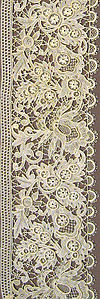- Needle lace
-
 Needle Lace borders from the Erzgebirge mountains Germany in 1884, displayed in the Victoria and Albert Museum.
Needle Lace borders from the Erzgebirge mountains Germany in 1884, displayed in the Victoria and Albert Museum.
Needle lace (also known as needlelace or needle-made lace) is a type of lace created using a needle and thread to stitch up hundreds of small stitches to form the lace itself.
In its purest form the only equipment and materials used are a needle, thread and scissors. This form of lace making originated in Armenia where there is evidence of a lace making tradition dating back to the pre-Christian era. Turkish needlelace is also very popular around the world. This form however arose separately from what is usually termed needlelace and is generally referred to as knotted lace. Such lace is very durable and will not unravel if one or more loops are broken.
Beginning in the 17th century in Italy, a variety of styles developed where the work is started by securing heavier guiding threads onto a stiff background (such as thick paper) with stitches that can later be removed. The work is then built up using a variety of stitches - the most basic being a variety of buttonhole or blanket stitch. When the entire area is covered with the stitching, the stay-stitches are released and the lace comes away from the paper. See reticella.
Needle lace is also used to create the fillings or insertions in cutwork.
External links
- Virtual Museum of Textile Arts
- Kenmare Lace And other forms of Irish Lace
- Needlelace - Lace Identification and Types
References
- "Structures of Antique Lace". A collection of Antique Laces. http://www.marlamallett.com/lace.htm. Retrieved July 26, 2005.
Lace types Needle lace Punto in Aria · Point de Venise · Point de France · Alençon · Argentan · Argentella · Armenian · Hollie Point · Halas lace · Point de Gaze · Youghal · Kenmare Lace · Limerick
Embroidered: Reticella · Buratto · Filet/Lacis · Ñandutí · Needlerun net · Tambour · Teneriffe
Cutwork: Battenberg · Broderie Anglaise · Carrickmacross
Bobbin lace Ancient: Antwerp · Ecclesiastical · Freehand · Torchon
Continental: Binche · Flanders · Mechlin · Paris · Valenciennes
Point ground: Bayeux · Blonde · Bucks point · Chantilly · Tønder · Beveren · Lille
Guipure: Genoese · Venetian · Bedfordshire · Cluny · Maltese
Part laces: Honiton · Bruges · Brussels
Tape: Milanese · Flemish · Russian · PeasantTape lace Mezzopunto · Princess · Renaissance · Romanian pointKnotted lace Crocheted lace Lace knitting Machine-made lace Categories:- Lace
- Textile stubs
Wikimedia Foundation. 2010.

